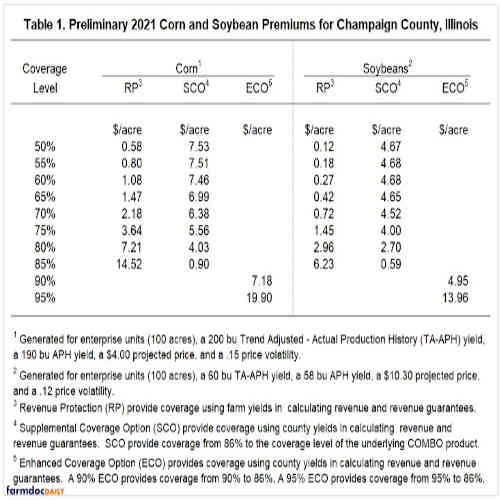By Gary Schnitkey and Nick Paulson et.al
Department of Agricultural and Consumer Economics
University of Illinois
By Carl Zulauf
Department of Agricultural, Environmental and Development Economics
Ohio State University
Enhanced Coverage Option (ECO) will be available for the first time in 2021. With ECO, purchasers of Revenue Protection (RP) or other COMBO products can extend county-level coverage up to a 90% or 95% coverage level. This article shows preliminary premiums for Champaign County, Illinois and estimated cost of coverage various combinations. In so doing, we aim to aid in coverage decisions associated with ECO.
Background
ECO is an endorsement to an eligible farm-level insurance plans such as RP, RP with the Harvest Price Exclusion (RP-HPE), and Yield Protection (YP). As the most widely used policy (farmdoc daily, November 17, 2020), RP will be used for presenting premium examples. When used with RP, ECO provides revenue protection with a guarantee increase. ECO’s protection will be based on county revenue rather than the farm revenue that is used by RP (see farmdoc daily, November 24, 2020, for more information).
ECO can be purchased at a 90% or 95% coverage level and will provide protection down to 86%. Supplemental Coverage Option, another county-level product, provides coverage from 86% down to the coverage level of the RP policy. ECO can be used in combination with the SCO to provide county coverage to the level of the underlying RP product. SCO is available only if Price Loss Coverage (PLC) is selected to receive commodity title payments. In contrast, ECO can be purchased even if Agricultural Risk Coverage is selected as the commodity title program.
RP, SCO, and ECO Premiums
Table 1 shows preliminary 2021 farmer-paid premiums for corn and soybeans in Champaign County, Illinois. These premiums are preliminary as projected prices and volatilities have not been set. In Table 1, premiums are based on projected prices of $4.00 per bushel for corn and $10.30 per bushel for soybean. Price volatilities are .15 for corn and .12 for soybeans, which are 2020 values and may differ from values for 2021. Both projected prices and volatilities will be set at the end of February 2021. The RP premiums are for enterprise units. More detail on yields used in calculations is provided in footnotes 1 and 2 of Table 1.

The combination of SCO and ECO offers farmers many options of coverage at each RP coverage level. These combinations will be illustrated for corn for RP at 80%. This RP-80% product will provide farm-level production beginning at the 80% coverage level for a farmer-paid premium of $7.21 per acre. With the RP-80% product, county coverage above 80% can be obtained in five different combinations:
- SCO will provide coverage from 86% to 80% for a $4.03 premium. As is always the case, SCO is only available if PLC is selected as the commodity title choices. RP and SCO will have a premium of $11.24 per acre ($7.21 RP + $4.03 SCO).
- ECO from 90% to 86% for a premium of $7.18 per acre. The combination of RP and ECO-90% will provide county coverage in the range from 90% to 86%, and RP will provide coverage from 80% down. Note that SCO does not have to be used with ECO and in this case, there is no product providing coverage between 86% and 80%. This RP-SCO combination has a cost of $14.39 per acre ($7.21 RP + $7.18 ECO)
- ECO from 95% to 86% for a premium of $19.90. The additional coverage from 90% to 95% has a substantial cost as there will be many years when this combination makes a payment. Again, note that SCO does not have to be used and there is a gap in coverage between 80% and 86%. The total cost of RP and ECO combination is $27.11 per acre ($7.21 RP + $19.90 ECO)
- ECO from 90% to 86% and SCO from 86% to 80%. Unlike option 2, which does not include SCO, this option provides coverage from 86% to 80%. The farmer-paid premium costs of this combination are $18.42 per acre ($7.21 RP + $4.03 SCO + $19.90 ECO)
- ECO from 95% to 86% and SCO from 86% to 80%. This combination has a total farmer-paid premium of $31.14 per acre ($7.21 RP + $4.03 SCO + $19.90 ECO).
Commentary
Several notes from the above comparisons:
- The cost of an ECO endorsement at a 95% coverage level is quite high. While payments likely will exceed farmer-paid premiums over time, the 95% coverage level’s cost may be a hindrance to its purchase.
- SCO does not have to be used with ECO. When evaluating combinations, it likely would be better to consider ECO first, and then consider adding SCO. For example, a combination of ECO-90% and RP-80% (#4) likely would be more beneficial than an SCO-86% and RP-80% (#1) if premium costs will prevent the purchase of all three.
- A RP-80% combined with an ECO-90% may be an option to consider as a replacement for RP-85%. Both have roughly the same costs, and ECO-90% provides more price protection than RP-85%. However, it offers less farm specific yield protection. There are tradeoffs to these two alternatives, and differing individuals could reasonably make different decisions.
Source : illinois.edu